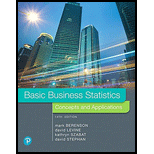
A freshly brewed shot of espresso has three distinct components: the hear, body, and crema. The separation of these three components typically lasts only 10 to 20 seconds. To use the espresso shot in making a latte, a cappuccino, or another drink, the shot must be poured into the beverage during the separation of the heart, body, and crema. If the shot is used after the separation occurs, the drink becomes excessively bitter and acidic, running the final drink. Thus, a longer separation time allows the drink-maker more time to pour the shot ensure that the beverage will meet expectations. An employee at a coffee shop hypothesized that the harder the espresso grounds were tamped down into the portafilter before brewing, the longer the separation time would be. An experiment using 24 observations was conducted to test this relationship. The independent variable Tamp measures the distance, in inches, between the espresso grounds and the top the portafilter (i.e., the harder the tamp, the greater the distance). The dependent variable Time is the number of seconds the hear, body and crema are separate (i.e., the amount of time after the shot is poured before it must be used for the customer’s beverage.) The data are stored in Espresso.
a. Use the latest-squares method to develop a simple regression equation with Time as the dependent variable.
b. Predict the separation time for a tamp distance of 0.50 inch.
c. Plot the residuals versus the time order of experimentation. Are there any noticeable patterns?
d. Compute the Durbin-Watson statistic. At the 0.05 level of significance, is there evidence of positive autocorrelation among the residuals?
e. Based on the results of (c) and (d), is there to question the validity of the model?
f. What conclusions can you reach concerning the effect of tamping on the time of separation?
Want to see the full answer?
Check out a sample textbook solution
Chapter 13 Solutions
EBK BASIC BUSINESS STATISTICS
- (c) Utilize Fubini's Theorem to demonstrate that E(X)= = (1- F(x))dx.arrow_forward(c) Describe the positive and negative parts of a random variable. How is the integral defined for a general random variable using these components?arrow_forward26. (a) Provide an example where X, X but E(X,) does not converge to E(X).arrow_forward
- (b) Demonstrate that if X and Y are independent, then it follows that E(XY) E(X)E(Y);arrow_forward(d) Under what conditions do we say that a random variable X is integrable, specifically when (i) X is a non-negative random variable and (ii) when X is a general random variable?arrow_forward29. State the Borel-Cantelli Lemmas without proof. What is the primary distinction between Lemma 1 and Lemma 2?arrow_forward

 Holt Mcdougal Larson Pre-algebra: Student Edition...AlgebraISBN:9780547587776Author:HOLT MCDOUGALPublisher:HOLT MCDOUGAL
Holt Mcdougal Larson Pre-algebra: Student Edition...AlgebraISBN:9780547587776Author:HOLT MCDOUGALPublisher:HOLT MCDOUGAL

